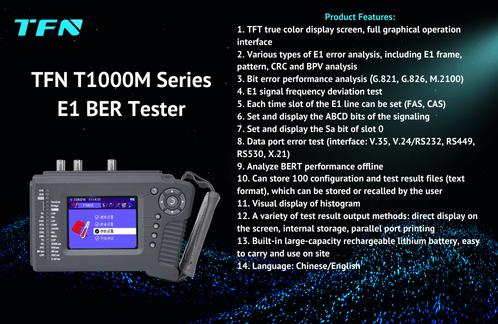Detailed explanation of the main parameters and functions of the TFN T1000M 2M bit error tester
The 2M bit error tester is a test instrument used to measure the bit error rate of the 2Mb/s interface in a digital communication system. It can simulate signal transmission, reception and synchronization, and calculate the number of bit errors by comparing the received signal with a predefined bit sequence, thereby deriving the bit error rate. The TFN T1000M 2M bit error tester is a handheld test device equipped with a true color screen and a full Chinese graphical interface, mainly used for bit error testing of E1/G.703 lines and data lines. The instrument is widely used in on-site maintenance, troubleshooting and quality inspection in the communications industry, and is an important tool to ensure the stability and reliability of digital communication systems. This article will introduce the main parameters and main functions of the instrument for user reference.

In terms of the main parameters, we mainly focus on its test rate and accuracy, interface type and compatibility, storage capacity, etc.
1. Test rate and accuracy: refers to the data transmission speed supported by the device. The T1000M 2M bit error tester ensures support for the standard test rate of 2.048Mbps (ie 2Mb/s), which is the basic test requirement for E1 lines. At the same time, it also supports variable rate testing of N*64Kbps (N=1 to 31) to meet the test requirements at different rates. Its high accuracy can accurately reflect the line performance.
2. Interface type and compatibility: including E1, data, clock, printing and data upload and other interfaces to meet different connection requirements. The T1000M 2M bit error tester provides a variety of interface types, including E1 interface (such as RJ45 balanced interface, BNC unbalanced interface), data interface (such as DB26 female interface), clock interface (such as PCM interface), printer port (such as DB15 female interface) and data upload port (such as USB driver-free interface). These interfaces ensure compatibility with a variety of communication devices and interfaces to support testing requirements in different scenarios.
3. Storage capacity: refers to the size of the storage space built into the device to be able to store sufficient test results and configuration data. The T1000M 2M bit error tester has sufficient built-in storage space to store up to 100 test results. Users can save and view test results at any time during the test process without worrying about insufficient storage space.
In terms of main functions, we mainly focus on its various types of E1 error analysis, error performance analysis, E1 signal frequency deviation test, time slot setting, signaling analysis, offline analysis of BERT performance, etc.
1. Various types of E1 error analysis: It can conduct in-depth analysis of various error types in E1 lines, including E1 frame structure, transmission pattern, CRC (cyclic redundancy check) and BPV (bit error rate), etc., to help users quickly locate the source of errors and understand the specific causes of errors.
2. Error performance analysis: It supports detailed analysis of the error performance of E1 lines in accordance with international communication standards (such as G.821, G.826 and M.2100) to ensure the accuracy and reliability of test results.
3. E1 signal frequency deviation test: It can detect the frequency deviation of E1 signals, that is, the difference between the actual frequency of the signal and the standard frequency. This function can evaluate the stability of signal transmission and promptly discover and correct frequency deviation problems.
4. Time slot setting: supports flexible setting of each time slot of E1 line, such as FAS (frame alignment signal) and CAS (channel association signal), etc. This function can meet different test requirements, realize accurate testing and analysis of specific time slots, and improve the pertinence and efficiency of testing.
5. Signaling analysis: It can set and display the ABCD bits of the signaling, and also supports setting and displaying the Sa bit of the 0 time slot, helping users to gain a deeper understanding of the transmission status and signaling structure of the signaling.
6. Offline analysis of BERT performance: It supports offline analysis of the performance of the BERT (bit error rate tester) without real-time test conditions, improving the flexibility and convenience of the test.
In addition to the above main parameters and functions, there are other aspects of the T1000M 2M bit error tester that we need to pay attention to: user interface and display, power supply and battery life, result display and visualization, physical size and weight, etc.
TFN T1000M 2M bit error tester can bring users an effective and accurate bit error test experience, support multi-standard and multi-interface testing, help quickly locate faults, and ensure communication quality. At the same time, its portable design and large-capacity storage facilitate on-site use and data management, and improve work efficiency.
If you are interested in TFN T1000M 2M Bit Error Tester, please contact TFN sales team:
Email: info@tfngj.com
WhatsApp: +86-18765219251
Facebook: https://www.facebook.com/tfnfate/
